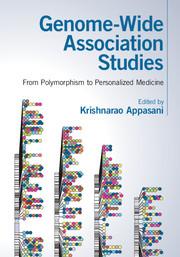Book contents
- Frontmatter
- Dedication
- Contents
- List of contributors
- Forewords
- Preface
- List of abbreviations
- Part I Genome-wide association studies
- Part II Genome-wide studies in disease biology
- 5 Genome-wide association studies of body mass index
- 6 Identification of myocardial infarction-susceptible genes and their functional analyses
- 7 Admixture mapping for disease gene discovery
- 8 Genome-wide association analysis in schizophrenia
- 9 Epigenome-wide association studies in neurodevelopmental disorders
- Part III Single nucleotide polymorphisms, copy number variants, haplotypes and eQTLs
- Part IV Next-generation sequencing technology and pharmaco-genomics
- Part V Population genetics and personalized medicine
- Index
- Plate section
- References
8 - Genome-wide association analysis in schizophrenia
from Part II - Genome-wide studies in disease biology
Published online by Cambridge University Press: 18 December 2015
- Frontmatter
- Dedication
- Contents
- List of contributors
- Forewords
- Preface
- List of abbreviations
- Part I Genome-wide association studies
- Part II Genome-wide studies in disease biology
- 5 Genome-wide association studies of body mass index
- 6 Identification of myocardial infarction-susceptible genes and their functional analyses
- 7 Admixture mapping for disease gene discovery
- 8 Genome-wide association analysis in schizophrenia
- 9 Epigenome-wide association studies in neurodevelopmental disorders
- Part III Single nucleotide polymorphisms, copy number variants, haplotypes and eQTLs
- Part IV Next-generation sequencing technology and pharmaco-genomics
- Part V Population genetics and personalized medicine
- Index
- Plate section
- References
Summary
Introduction
Schizophrenia is a severe mental disorder with a typical onset in adolescence or young adulthood. Global lifetime prevalence is about 0.3–0.7% (van Os and Kapur, 2009). Symptoms can be divided into positive symptoms (e.g., delusions and hallucinations), negative (deficit) symptoms (e.g., anhedonia, blunted affect, and avolition), and disorganization symptoms (e.g. disorganized speech). In addition, the majority of schizophrenia patients show cognitive dysfunctioning. In general, schizophrenia patients have deficits in most cognitive domains (e.g., attention, memory, and executive functioning) approximately one standard deviation below the normative mean (Mesholam-Gately et al., 2009). However, there is no specific cognitive profile that distinguishes schizophrenia patients from patients with other Diagnostic and Statistical Manual of Mental Disorders (DSM) (American Psychiatric Association, 2000) diagnoses. Schizophrenia is often preceded by a prodromal period of months to years in which mild psychotic and other symptoms can occur and psycho-social functioning deteriorates.
A short case example:
Michael is a 20-year-old philosophy student who has been skipping a lot of classes lately. In the class room he hears his name being whispered by fellow students in the front row, although the distance is too far to be able to hear them. During the breaks, he hears other students talk and laugh about him. Sometimes he thinks they are conspiring to kill him, especially because he also hears them talking about how they are going to get him when he is alone in his room. He is unable to concentrate on what the professor says in the classroom. It is as if he cannot extract the meaning of what is being said. He has suffered from that problem for several years. His grades have decreased during this period and he will probably drop out from university. He also experiences a feeling of emptiness, which started years ago. Nothing seems to get through to him. Even the birth of his niece left him cold. He experiences a loss of identity. Lately, he sometimes has the feeling that someone else is putting thoughts in his head or moves his limbs outside his own will.
Schizophrenia has remained a mental disorder with an unknown etiology, unchanged prevalence, and disabling outcomes for the vast majority of the patients. Sustained recovery occurs in less than 14% within the first five years following a psychotic episode and in an additional 16% in a later phase (Harrison et al., 2001; Robinson et al., 2004).
- Type
- Chapter
- Information
- Genome-Wide Association StudiesFrom Polymorphism to Personalized Medicine, pp. 106 - 122Publisher: Cambridge University PressPrint publication year: 2016

